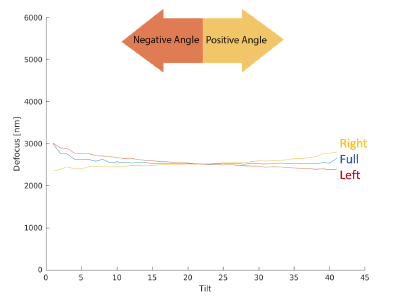Difference between revisions of "Tilt angle convention"
| Line 16: | Line 16: | ||
* Thus, higher heights in the tomogram are more underfocused (i.e., have larger defocus values). | * Thus, higher heights in the tomogram are more underfocused (i.e., have larger defocus values). | ||
| − | For visual reference, check Figure | + | For visual reference, check Figure 1 in [https://reader.elsevier.com/reader/sd/pii/S1047847717301272?token=8E810667E3A42758016F23FA22A4C948318CB5698DA54E24EECEAF234754D8ED9262F1B595440D0309C15DD33EF26808 Journal of Structural Biology 199 (2017) 187–195.]. Dynamo follows the convention depicted there. |
Revision as of 12:41, 10 June 2020
Dynamo, IMOD and novaCTF, by default, all use the same convention for the sign of the tilt angle of an image within a tilt series: At positive tilt angles, the right side of the tilt images is expected to be more underfocused than the left side. It is important that the tilt angles of your corresponding tilt series follow this convention. This ensures that within these different software packages the true handedness of the tomogram is not lost, the CTF corrections are done properly and missing wedge masks for incomplete tilt series are applied correctly.
To test if the angles in your tilt series follow the convention, the defocus on the left and right side of the tilt series can be estimated and plotted against the angles of the corresponding tilt angle file. It is recommended to use the aligned tilt series for this estimation because there the tilt axis goes vertical through the center and it will also not change its orientation anymore in later processing steps. The result should look more or less like the following figure. An example function to generate this plot can be found in TomographyTools.

If this is not the case, the angles in the tilt file have to be adapted accordingly. To be completely certain, after correcting the signs of the angles, a rearrangement of the images in the stack can be made so that the first tilt image has the angle of -60 degrees. Alternatively, instead of changing the tilt angle file, the tilt image stack itself can be rotated by 180 degrees. In both cases, be aware of what processing steps were already made with the wrong convention and if some of them need to be repeated with the correct angle convention. After having applied the corrections, plot again the defocus to double check that everything has worked well.
Cheat sheet
- By convention, "underfocus" entails positive defocus values.
- For negative tilt angles, the left side of the images should be more underfocused than the right side.
- A positive tilt angle means that the stage has been tilted by that angle clockwise about the positive y direction.
- Thus, higher heights in the tomogram are more underfocused (i.e., have larger defocus values).
For visual reference, check Figure 1 in Journal of Structural Biology 199 (2017) 187–195.. Dynamo follows the convention depicted there.